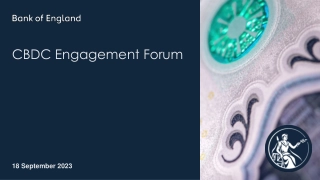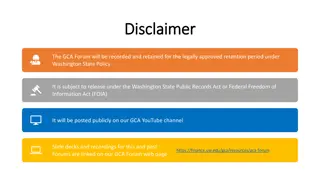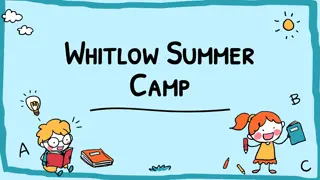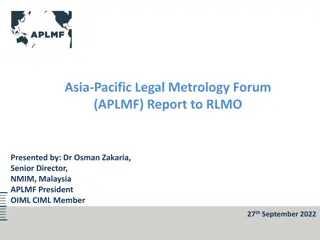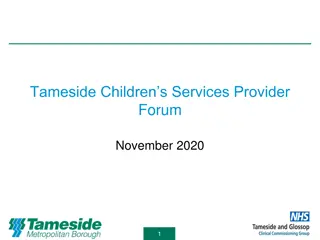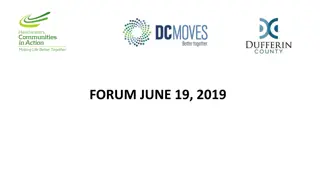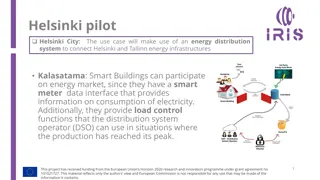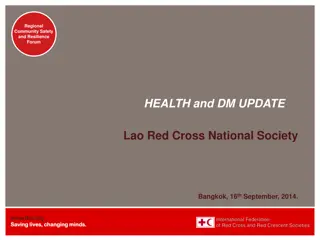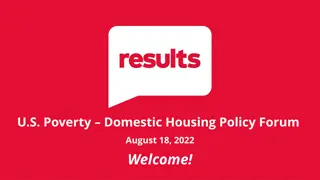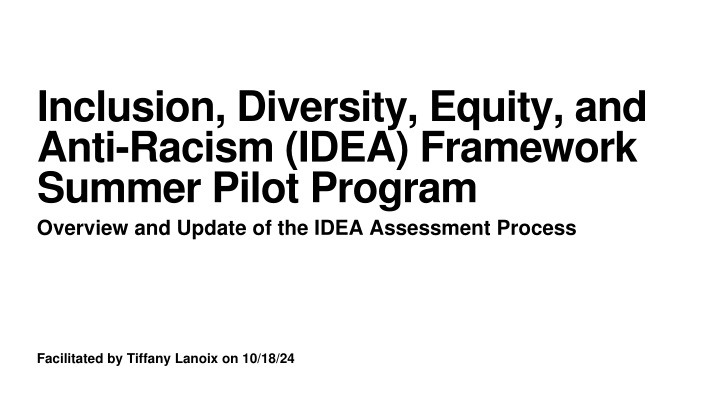
The IDEA Framework for Inclusion and Anti-Racism Assessment
Explore the Inclusion, Diversity, Equity, and Anti-Racism (IDEA) Framework and its assessment process. Learn about the IDEA Summer Pilot Program, faculty support, and the goals of promoting culturally responsive pedagogy in education.
Download Presentation

Please find below an Image/Link to download the presentation.
The content on the website is provided AS IS for your information and personal use only. It may not be sold, licensed, or shared on other websites without obtaining consent from the author. If you encounter any issues during the download, it is possible that the publisher has removed the file from their server.
You are allowed to download the files provided on this website for personal or commercial use, subject to the condition that they are used lawfully. All files are the property of their respective owners.
The content on the website is provided AS IS for your information and personal use only. It may not be sold, licensed, or shared on other websites without obtaining consent from the author.
E N D
Presentation Transcript
Inclusion, Diversity, Equity, and Anti-Racism (IDEA) Framework Summer Pilot Program Overview and Update of the IDEA Assessment Process Facilitated by Tiffany Lanoix on 10/18/24
Agenda What is the IDEA Framework? What was the IDEA Framework Summer Pilot program? Findings Next Steps Consideration
IDEA Framework Background OERI Expanding availability and adoption of high-quality OER materials Freely available online Support implementation efforts Professional development, technical support, and technical resources
IDEA Framework Purpose Support faculty as they implement culturally responsive and anti-racist pedagogy Provide a process and review framework to evaluate existing ASCCC OERI- supported materials Inclusive, diverse, equitable, and anti-racist (IDEA) Encourage consideration of how we know what we know and how education has been shaped by those in power
What do we mean by IDEA? Inclusion, diversity, equity and anti-racism Inclusion: Intentional efforts to ensure students feel welcome, included, respected, and valued Diversity: Materials are representative of the varied experiences of our diverse student body Equity: Address issues of access to and relevancy of course materials for historically marginalized groups Anti-racism: Materials do not attempt to be culturally neutral since doing so perpetuates racial and ethnic inequities and white supremacy
IDEA Summer Pilot Program What was it? Recruited CCC faculty to participate in a summer pilot project to help build the ASCCC OERI s IDEA Framework assessment process 4 week program Meet once a week (2 hour sessions) w/outside readings & assignments Goals: Test training curriculum and activities Conduct assessments of OER Learn more about assessment timelines
IDEA Summer Pilot Program What did we do? Week One: Introduction to the IDEA Framework Culturally responsive & anti-racist pedagogy White supremacy & education Implicit bias Assignment: affinity bias assignment & review IDEA Framework & Implementation Guidebook
IDEA Framework Assessment Categories Illustrations and Photos Example Names Gender Inclusive Language and Use of Pronouns Diverse Authors, Researchers, and Studies Applications, Examples, and Problem Scenarios that Relate to Diverse Audiences Appropriate Terminology Keyword, Glossary, and Metadata Representation Incorporating Diverse Perspectives on Issues, Events, and Concepts that are Relevant to Underrepresented Groups
IDEA Summer Pilot Program Way did we do? Weeks Two & Three: Assessment Categories Review and apply assessment categories Review and apply rubric Assignment: OER assessments, rubric survey, continuing to review IDEA Framework & Implementation Guidebook Week Four: Wrap Up Final assessment, rubric and IDEA Framework & Guidebook surveys and feedback Question, concerns and debrief
IDEA Summer Pilot Program Findings & Feedback General consensus that the following was useful IDEA Framework & Implementation Guide IDEA Rubric Training curriculum & activities Time Assessments got quicker 1st assessment: Chapters assessments hovered around 2-3 2nd assessment: 1-2 hours
What did you find useful about the rubric? What worked well? Please provide specific examples and a thorough explanation. The rubric was very detailed and useful in assessing the OER materials. The categories are clear and the 3 levels (exclusive, emerging, and inclusive) were easy to distinguish. I think that the counting was useful. It's like in the affinity bias: you might "feel" like there is diversity, but there actually isn't when you start counting. For example, I felt like there were way more women artists when I started reading the Art History textbook, but when I counted there were over double the number of pictures by men than by women. I think the rubric is set up very nicely in regard to how difficult it can be to quantify things at times. Having the option to consider these resources either as exclusive, emerging, or inclusive made the evaluation process a lot easier. I appreciated the clarity and alignment with the IDEA framework.
Do you have any suggestions for improving the rubric for categories? Please provide specific examples and a thorough explanation. No The percentages in Categories 1 & 2 didn't seem necessary because the quantity seems less important than the appropriateness for the context. Even though there might be a high percentage of photos and illustrations featuring BIPOC individuals, the context in which they are used might compromise the frequency of their representation. I would add the notes area to the table after each category, and make the font larger in the fillable PDF. I also suggest having something different for art textbooks or at least add a way to count pictures with people compared to without people, and then start on counting the gender and ethnicity of the people in the pictures. I honestly think the rubric is in really good condition. My only small feedback on potential change would maybe to be rearrange the notes area since there are two areas for each category and then general notes. The way my brain operates I would like to have just all the categories be subheadings under notes but that is just personal preference and the rubric in its current state is fine to me! "I found it frustrating that I had to use ""does not apply"" twice while the framework encourages the application of all categories to support IDEA principles. Perhaps we should consider developing a different category to better guide OER authors in effectively applying IDEA principles. It could lead to more comprehensive and inclusive educational resources. It would be helpful to have fields under each category for notes rather than at the end of the document. The fields for section notes utilize very small font - like 9pt. Could we make that bigger? It is super hard to read - in fact, I couldn't read my own notes in the Diverse authors field unless I increased the magnification to 200%. The other fields which have fewer notes needed to be increased to 150%. This makes the form unwieldy.
What did you find useful about the IDEA Framework & Implementation Guide? What worked well? Please provide specific examples and a thorough explanation. It was very useful to pinpoint specific ways in which textbooks continue to implicitly and explicitly reinforce colonialist and racist, sexist, ableist ideologies. This assessment process helps spotlight how even the seemingly most casual reference carries a lot of weight in terms of representation and validation of our students but also of ourselves as faculty of color. It is empowering, though, to conduct this assessment process and feel like we have a space to voice back how these textbooks marginalize, if not erase, our histories in the name of "science" or "medicine" or objectivity." It is an excellent reference document to have in hand while evaluating. I think the best part were the examples provided in each section. Examples such as ableist language (blind spot) and cultural context (Saving Private Ryan) were super helpful in making the concepts concrete. I would add more in the sections that are missing specific examples. In general, having 3 categories makes it easier to quantify and measure where the resource/textbook is in terms of the categories. I liked the focus on pedagogy, and the summary of culturally responsive pedagogy. The quote from Sleeter (2011) about how making something more representative isn't enough was also enlightening. It's not just "diverse" in IDEA that is needed. The examples are very helpful to understand how to apply the IDEA principles.
Do you have any suggestions for improving section IDEA Framework & Implementation Guide? Please provide specific examples and a thorough explanation. Regarding race and ethnicity, it is easy to view things in black and white, both literally and figuratively. A picture is worth a thousand words and it can be powerful to include even more pictures demonstrating the diversity we are aiming to create in OER. For instance, Islamophobia is a very present problem in U.S. society and it would be helpful to increasingly show inclusivity in illustrations/examples. Section 0.0-6.0 is an ideal starting point for anyone interested in IDEA. Within this topic my go to suggestion would always be to include information/data on who is authoring current and past materials to show the disparities but since that is covered, I'd say this section is well covered. Maybe more examples. Terminology and application are very discipline specific and there needs to be more sub categories that acknowledge the range of discipline or major categories like Science, and Social Sciences. "In 7.4, maybe add some examples of how you'd phrase the acknowledgement that the field is based on the ideas of cis, straight, white men (from Europe/US). After doing the rubric, I would suggest have a successive rubric that only focused on one thing (like racial and global representation of topics), then moved on to only look at culturally-relevant examples, and then maybe look at the social identities of the experts in the field, etc. It's just a lot to try to review at once (even just one category).
Next Steps Update rubric and guidebook Build the assessment process Application process Preferred skills & qualifications Trainings Self paced, facilitated Assessments Individual or multiple assessors; cross/within disciplines Calendar Trainings, assessments and author submissions Compensation Creating IDEA Assessment Stamp Repository for IDEA approved materials
Considerations What should we keep in mind as we build out the IDEA Framework Assessment process? OER authors Assessors

